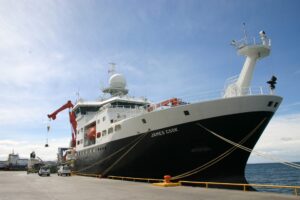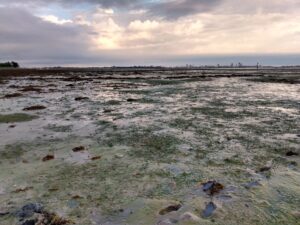Investigating the source and reactivity of Blue Carbon stocks and their vulnerability to disturbance and environmental change
Investigating the source and reactivity of Blue Carbon stocks and their vulnerability to disturbance and environmental change
Blue Carbon refers to carbon stored and sequestered in the marine environment. The term has typically referred to coastal vegetated habitats, but there is now a growing focus by researchers and policy makers on subtidal shelf sea sediments where large quantities of carbon are known to be stored (Kroeger et al., Diesing et al., 2017). Governments, environmental management agencies and NGOs are increasingly interested in Blue Carbon stores, due to their potential to be included in carbon offsetting, emissions accounting and natural capital accounting. Additionally, there is growing recognition that formulation of marine management strategies is an urgent requirement protection of sedimentary Blue Carbon stores as anthropogenic and climate pressures grow(Epstein et al., 2022; Black et al., 2022; Clare et al., 2023) .
Several decades of research have resulted in knowledge of a range of factors which influence the efficiency with which organic carbon is stored and buried in sediments (Middelburg, 2018). These include organic carbon source and degradation history, sedimentation rates, sediment grainsize, association with mineral surfaces, and exposure to oxygen. Despite this knowledge however, there remain major gaps in our understanding of the geochemical mechanisms responsible for sedimentary carbon preservation, which currently prevent predictions of how much carbon will be stored under any given conditions. This also means that models predicting organic carbon decay in sediments under current and future climate conditions have to make assumptions about the rates at which it decays, and those assumptions are not underpinned by empirical data (Arndt et al., 2013).
Many studies recognise that the composition of organic carbon is an important determinant of the extent to which it is stored or preserved in sediments (Burdige, 2007, and references therein). Composition in turn can be driven by the initial source of the organic matter (e.g. terrestrial plat matter, soil organic carbon, or marine phytoplankton), and the degradation processes which have already occurred before and after deposition in the sediment. However, the bulk of sedimentary organic matter is molecularly uncharacterisable (Burdige, 2007), which hinders understanding of organic matter source. Further, while several organic geochemical proxies have been developed as indicators of the extent of prior decay, neither these nor organic matter source information have been linked to actual measured rates of organic carbon decay.
This PhD project will make use of extensive sampling efforts currently being undertaken by the Centre for Environment, Fisheries and Aquaculture Science (Cefas), as well as planned experimental work as part of a forthcoming £2.1 M project on the Blue C impact of trawling. Samples will be collected representing a large proportion of UK shelf seas, and the full range of environmental conditions which occur. Organic matter will be characterised using a wide range of techniques (e.g. bulk stable isotopes, 14C dating, pigments, amino acids, thermogravimetric analysis, pyrolysis GC-MS, ramped pyrolysis oxidation analysis), which will be directly cross referenced for the first time, to provide information on organic carbon source and degradation history. These results will then be compared to results of degradation experiments in which organic carbon decay rates are directly measured, providing a basis for use of organic geochemical parameters to properly inform Blue Carbon modelling in the future.
By understanding the mechanism that govern the preservation of organic matter in the marine sedimentary environments we will be better placed to design scientifically robust management strategies to deal with growing pressures derived from increasing anthropogenic activities and a changing climate.
This project will be supervised by leading researchers in the field at the University of Leeds, and the University of St Andrews. Co-supervision will be provided by researchers from Cefas, whose input will also provide links to the policy relevance of the science. The research student will participate in seagoing fieldwork on the UK shelf, and will undertake work experience at Cefas as part of their research and studentship.
References
Arndt, S., Jorgensen, B. B., LwRowe, D. E., Middelburg, J. J., Pancost, R. D., Regnier, P., 2013, Quantifying the degradation of organic matter in marine sediments: A review and synthesis. Earth-Science Reviews 123, 53-86
Black, K.E., Smeaton, C., Turrell, W.R. and Austin, W.E., 2022. Assessing the potential vulnerability of sedimentary carbon stores to bottom trawling disturbance within the UK EEZ. Frontiers in Marine Science, 9, p.892892.
Burdige, D. J.: Preservation of organic matter in marine sediments: Controls, mechanisms, and an imbalance in sediment organic carbon budgets?, Chemical Reviews, 107, 467-485, 2007.
Clare, M.A., Lichtschlag, A., Paradis, S. and Barlow, N.L.M., 2023. Assessing the impact of the global subsea telecommunications network on sedimentary organic carbon stocks. Nature Communications, 14(1), p.2080.
Diesing, M., Kroeger, S., Parker, R., Jenkins, C., Mason, C., Weston, K., 2017, Predicting the standing stock of organic carbon in surface sediments of the North-West European continental shelf. Biogeochemistry, DOI 10.1007/s10533-017-0310-4
Epstein, G., Middelburg, J.J., Hawkins, J.P., Norris, C.R. and Roberts, C.M., 2022. The impact of mobile demersal fishing on carbon storage in seabed sediments. Global Change Biology, 28(9), pp.2875-2894.
Kröger S, Parker R, Cripps G & Williamson P (Eds.) 2018. Shelf Seas: The Engine of Productivity, Policy Report on NERC-Defra Shelf Sea Biogeochemistry programme. Cefas, Lowestoft. DOI: 10.144Arndt65/2018.ssb18.pbd
Middelburg, J. J., 2018, Reviews and syntheses: to the bottom of carbon processing at the seafloor. Biogeosciences 15, 413-427. https://doi.org/10.5194/bg-15-413-2018

